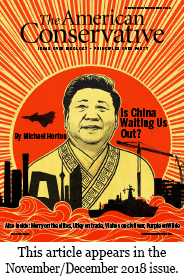- Reaction score
- 146
- Points
- 710
Growing CCP China threat--excerpts from piece at Macdonald-Laurier Institute:
Mark
Ottawa
Disruptive innovation in China’s military modernization: Preston Lim for Inside Policy
At the end of August, China’s second aircraft carrier sailed from its shipyard in Dalian, in northeastern China, to commence final sea trials. The 65,000-tonne vessel is China’s first domestically-built carrier and could be fully operational as early as October 2019. Some have identified technological issues with the ship, but most analysts agree that the PLA Navy (PLAN) is entering a new era: one characterized by force projection rather than mere regional defence.
Many of those writers, while essentially correct, have missed an important point: the aircraft carrier is far from the most important tool in China’s growing armoury. This article applies the theory of disruptive innovation to examine some of the ways in which the Chinese are transforming naval warfare – most notably, through investment in anti-access/area denial (A2/AD) capabilities.
China’s military build-up – symbolized most boldly by the carrier construction program – is part and parcel of President Xi Jinping’s articulation of a new “Chinese Dream.” At the 19th Communist Party Congress, held in October 2017, Xi promised to achieve the “great rejuvenation of the Chinese nation,” with plans to boast a “world-class army by 2050.” To understand President Xi’s focus on the military, it is important to revisit China’s modern history.
President Xi and other Chinese leaders have tended to see China’s recent record as one of national humiliation. The 19th and 20th centuries were defined by foreign colonial intervention in Chinese domestic affairs, with calamity following calamity: the Opium Wars, the failed Boxer Rebellion, and the Sino-Japanese War, which became part of the Second World War. As late as 1996, the Chinese government was left helpless when American aircraft carriers sailed through the Taiwan Strait with impunity during a spat between China and Taiwan.
Now, the long “century of humiliation” is over. And despite slowing economic growth, caused only in part by the ongoing trade war with America, President Xi remains intent on building a Chinese dream undergirded at least in part by military muscle.
China’s military rejuvenation has, on one hand, come in the form of increased spending, with Beijing boasting a defence budget of $227 billion. Indeed, the sheer number of new naval platforms, with 18 ships commissioned in 2016 alone, is nothing short of incredible. Though naval analysts continue to debate whether or not the PLAN is a “blue-water navy” – i.e., capable of exercising “sea control at long ranges” – China’s force projection capabilities will only improve in coming years.
Yet perhaps a more important criterion of China’s growing military clout is investment in technological development. In other words, to focus on traditional terms of comparison, such as total defence outlays or number of aircraft carriers, would be to obscure a critical aspect of China’s military ascendance. While China has proven capable of domestically producing traditional weapons systems – the J-20 “Chengdu” fifth-generation stealth aircraft, for example, or the Type 001A aircraft carrier currently undergoing sea trials – its real genius lies in its embrace of disruptive innovation...
China has in recent years developed an array of anti-aircraft and anti-ship missiles, which would render American operations in the South China Sea difficult in the event of hostilities. Chinese anti-ship ballistic missiles, such as the DF-21D or the DF-26, are capable of at least disabling (if not destroying) a super-carrier or its escorts. The recently-commissioned DF-26 has a range of 3000-4000 kilometers and can even reach as far away as US facilities on Guam, making it an ideal weapon to forestall American naval entry into the Western Pacific.
The Chinese have creatively deployed shorter-range anti-ship missiles that would reduce America’s ability to operate freely in the littoral zone...
Anti-ship missiles and a growing submarine fleet are but the most conspicuous items on a long list of A2/AD competencies. The Chinese are developing lasers to disrupt enemy aerial operations, unmanned vehicles, and a range of other complementary capabilities. Such technologies will allow the Chinese military to at least partially offset American military dominance...
Responding to the Chinese missile threat means meeting innovation with innovation. The American military has already pioneered a repertoire of counter-A2/AD systems, including “long-range strike vehicles, hyper-sonic weapons…and submarine launched cruise missiles.”..
...Western analysts will need to pay attention to the right metrics. While China’s capital ships are certainly important, China’s embrace of disruptive innovation will prove far more consequential in the long term. To ensure continued relevance, the United States and its alliance partners will likewise need to prioritize continual and disruptive innovation.
Preston Lim is a graduate of the Schwarzman Scholars program and received his Master’s in Global Affairs from Tsinghua University.
https://www.macdonaldlaurier.ca/disruptive-innovation-chinas-military-modernization-preston-lim-inside-policy/
Mark
Ottawa






